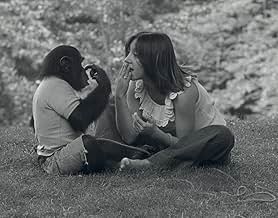Tells the story of a chimpanzee taken from its mother at birth and raised like a human child by a family in a brownstone on the upper West Side in the 1970s.Tells the story of a chimpanzee taken from its mother at birth and raised like a human child by a family in a brownstone on the upper West Side in the 1970s.Tells the story of a chimpanzee taken from its mother at birth and raised like a human child by a family in a brownstone on the upper West Side in the 1970s.
- Nominated for 1 BAFTA Award
- 16 wins & 30 nominations total
- Self
- (archive footage)
- Self
- (archive footage)
- Self
- (as Dr. James Mahoney)
- Self
- (archive footage)
- Director
- Writer
- All cast & crew
- Production, box office & more at IMDbPro
Featured reviews
The movie is more about a team of people trying to salvage and place an off the track train back on it, when the damage was already done.
The story starts out well, with the impossibly cute baby chimp brought up as a human. Soon, though, the behaviour of some of the "scientists" looking after Nim begins to grate; some of them are a little too involved with their subject, while others are plain creepy. Later, Nim suffers a huge betrayal, and at this point the documentary takes a downward turn into one of the most depressing ever.
Hardly a heartwarming story then, in that it focuses on misery and despair for the majority of the running time, but nevertheless an important story that serves to highlight man's inhumanity towards the world he inhabits.
This is roughly the sequence of events that befell a chimpanzee named NIM, and is the subject of a haunting and disturbing documentary by James Marsh, who made "Man On Wire."
Behavioural scientist Herbert Terrace at Columbia University in New York, believed that as 98.7% of the DNA in humans and chimpanzees is identical, he wanted to conduct an experiment by having a chimp raised in a human family and taught to communicate using American Sign Language. And thereby disprove the foremost authority on linguistics, Noam Chomsky, whose theory was that only humans have language. Herbert Terrace called his experiment "Project NIM."
At three or so months old, a chimp is like a small puppy – frisky, playful, and much, much more destructive. Fully grown, a male chimp can grow up to 1.7 metres and weigh up to 70 kilos. They are very, very strong, and have a high level of aggression. In one scene, NIM becomes frightened and angry, and it took four strong men to subdue him.
The project was conducted in the early seventies, not long after the phenomenon of Woodstock and at the tail end of the Hippie Movement. The first family, who took on the responsibility to raise NIM, were totally unprepared for the impact NIM would have on their lives. To say they were overwhelmed is an under-statement. Eventually, it got all too much for them, and NIM was transferred to a huge house set in large grounds outside New York, that Herbert Terrace thought might be a more suitable location to conduct his experiment.
Eventually, even after NIM showed he could 'understand' sign language, Herbert Terrace finally admitted defeat. "Project NIM" was not the success he had hoped for, and the project is abandoned.
"Project NIM" was not so much about a how intelligent chimps are, but how conceited we are to think that we can mould a chimp into acting and communicating like we do.
The very idea of a chimp being brought up in human society is a fascinating one. But it quickly becomes apparent that this experiment is doomed to failure. There is a very good reason that you do not see people keep chimpanzees as pets – they can be extremely aggressive and powerful animals. On numerous occasions carers were bitten and maimed. One woman had a hole ripped in the side of her face while another had her head repeatedly beaten off the pavement by the ape. But the over-riding feeling engendered by the documentary is one of sadness. This poor creature is let down by those who took him from his mother and decided to rear him as a human. It seems to me quite outrageous that an animal taught to communicate with people and live in a house should ever have been sent to an animal experiment centre. The blame must surely be primarily put on Professor Herbert Terrace whose project it was. Once Nim was sent to a chimp reserve he seemingly lost interest and made absolutely no attempt to save him from what could have quite easily have been an awful fate. So thank heavens for Bob Ingersoll the man who looked after Nim in the reserve and never gave up on him. Bob ultimately saved him through perseverance and considerable effort. He emerges as the human hero of the film, although the other carers from New York such as Laura and the young couple who followed her also cared deeply for the animal too, the latter two still seemed genuinely pained by how Nim was ultimately treated.
The essential message of the film is that you should not try to transport a wild animal into human society and not expect repercussions. Some of the people in the film are just guilty of naivety, dangerous as it was. As much as a story about a remarkable primate, it's a story about human stupidity, human callousness and – thanks to Bob Ingersoll – human kindness. It's overall a remarkable documentary.
Firstly, I do agree with the other reviewers comments on futility, I do not, however, agree entirely with Professor Terrace's view that the project was a failure, though conversely I do think the project failed Nim. To expand on this I would say that the conclusion of Terrace's failure seemed to fit a classic narrow set of parameters by which you compare and judge the outcome solely on an initial and highly specific expectation of what you will achieve. To this end perhaps it failed Professor Terrace's criteria.
I think however opportunities were certainly lost. Nim seemed to interact in so many subtle and fascinating ways during the process of his teaching, and he seemed to teach a great deal to all of the assistants who gave him their care. There seemed to be so little structure from the start with regards to what was to be taught and observed and in which direction the project should be going.
The only constant seemed to be the teaching of signing, at which Nim excelled! From what I could see, regardless of whether he learnt the actions to manipulate his handlers or not, he still learnt the signs. Since it was known that the chimp could not form human speech, how was it to communicate what it had learnt and why it was using the language in this way? I found this point frustrating and dubious and an example of one person with their eye so "firmly on the prize", that they miss the importance of the process.
Importantly, everybody who was involved across the duration of the project was given a chance to clearly state the turn of events. Perspectives on this varied widely, as you would expect, as everybody brought a different set of expectations and sensibilities, but it was a mature approach which I think led to the films balanced handling of Nim's story.
All in all I found it a fascinating cautionary tale. Luckily the balance of academic ego versus humanity that twists through this story left me with hope that indeed something had been learnt from the unique life of this Chimpanzee.
Did you know
- TriviaVeteran primate choreographer and actor Peter Elliott actually met and worked with Nim Chimpsky when he was researching chimpanzees for Greystoke, la légende de Tarzan (1984). He also met and worked with another famous signing chimp by the name of Washoe.
- Quotes
Herbert Terrace: Wouldn't it be exciting to communicate with a chimp and find out what it was thinking? If they could be taught to articulate what they were thinking about, this would be an incredible expansion of human communication, and possibly give us some insight into how language, in fact, did evolve.
- ConnectionsFeatured in Maltin on Movies: Harry Potter and the Deathly Hallows: Part 2 (2011)
- SoundtracksCollide
Written by Autumn Rowe
- How long is Project Nim?Powered by Alexa
Details
Box office
- Gross US & Canada
- $411,184
- Opening weekend US & Canada
- $25,820
- Jul 10, 2011
- Gross worldwide
- $612,839
- Runtime1 hour 33 minutes
- Color
- Sound mix
Contribute to this page




























